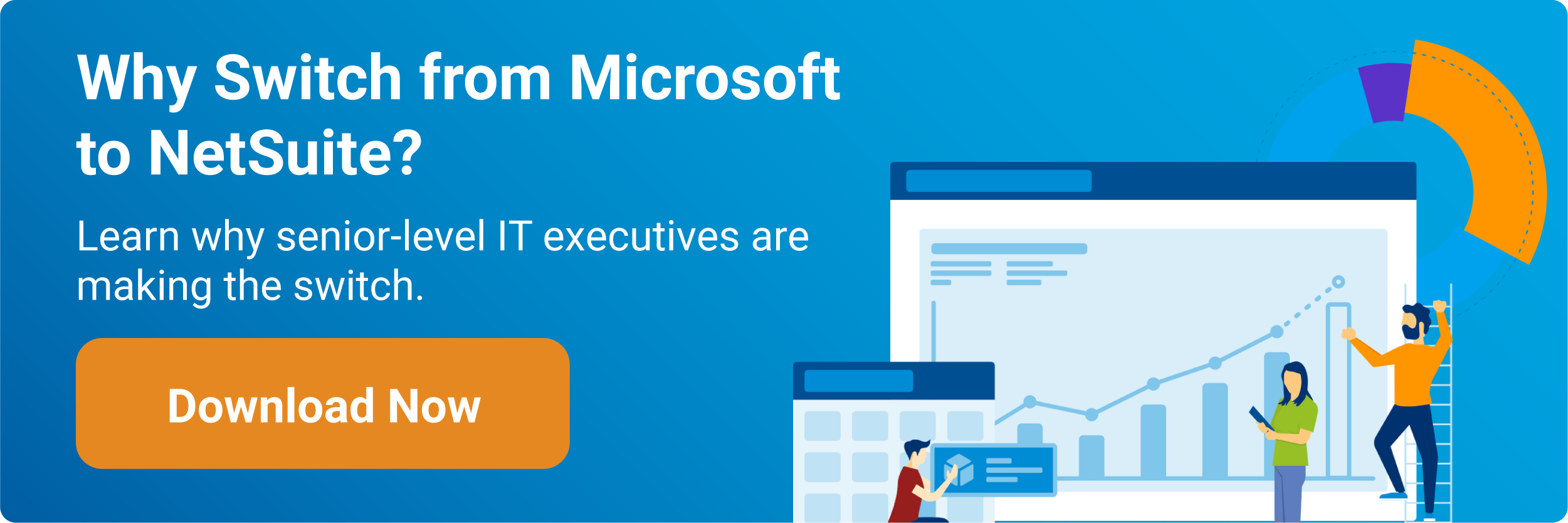
Are you thinking about making a change from Microsoft Dynamics GP? You’re not the only one. If you have only had experience with this Microsoft-based ERP solution, then you may wonder if a change will genuinely make a difference to your business. The short answer is that a switch to NetSuite can save you time and frustration by providing access to a range of seamlessly integrated solutions.
Below, we list 13 of the top reasons companies are moving from Microsoft Dynamics GP to NetSuite.
1. NetSuite’s approach to the cloud
Businesses of all sizes can use Microsoft Dynamics GP on the cloud via third-party partners, but it was developed as an on-premise solution. Because GP still has a legacy architecture that isn’t cloud-native, specific processes can only be completed by batch. Batch processing can lead to reconciliation issues at the end of the month, should one user forget to update a related module.
NetSuite was developed as a pure cloud solution to allow users to access information anytime, anywhere. As a cloud-based solution, NetSuite also ensures that updates made at one location are seen in real-time by all other users.
2. Ease of access
Companies exploring the feasibility of remote or hybrid work processes are now recognizing just how critical it is to have a cloud-based solution. Organizations using Microsoft Dynamic GP on-premise solutions have invested in new solutions to make remote arrangements work. NetSuite has always offered the advantage of cloud-based access.
3. CRM functionality
NetSuite’s customer relationship management (CRM) software is fully integrated into its ERP solution. The software offers a holistic view of the customer lifecycle, from lead generation through sales, fulfillment, renewal, cross-sales, and support.
Microsoft Dynamics GP does not have a built-in CRM. CRM support requires the purchase and integration of Microsoft Dynamics CRM or another third-party solution. However, because Dynamics CRM was designed with a different code set, there can be challenges in integrating the CRM product with Dynamics GP.
4. Microsoft Dynamics GP vs. NetSuite eCommerce integration
For an e-commerce storefront, Microsoft Dynamics GP users must purchase Microsoft GP eConnect or another solution from a third-party provider.
NetSuite, however, provides both eCommerce and point-of-sale solutions that seamlessly connect customer touchpoints. Much like its CRM software, the NetSuite commerce integration offers a total view of data around inventory, customers, and order information.
5. Automatic upgrade capabilities
Microsoft Dynamics GP offers control of upgrades to its users. However, this means users risk missing out on valuable upgrades that eliminate newly identified security risks.
The beauty of a cloud-based SaaS software like NetSuite is that the provider manages all necessary upgrades to ensure that your organization runs the latest software version. This ensures seamless operation.
6. Microsoft Dynamics GP vs. NetSuite add-ons
NetSuite provides hundreds of possible integrations developed in-house to allow users to create custom solutions for their business needs. Businesses can add further integrations as new solutions are needed. This customization also means that users only pay for what they need as they need it.
Microsoft Dynamics GP also allows for integrations, but these are provided as third-party-developed add-ons. Not all of these add-ons are built for use on the cloud, and not all work seamlessly with other add-ons. These add-ons also mean users will need to work with multiple vendors if something doesn’t work as expected.
7. Microsoft Dynamics GP vs. NetSuite dashboards
Microsoft Dynamics GP does not offer built-in dashboards. There is an ability to build custom dashboards using tools provided in GP, and third-party providers have developed downloadable templates that can be used as a starting place for more valuable dashboards.
Pre-packaged dashboards that provide a comprehensive view of business and customer actions are a crucial part of the NetSuite solution. In addition, third-party NetSuite providers can create meaningful NetSuite dashboards to give businesses immediate insight into the metrics that matter.
8. Microsoft Dynamics GP vs. NetSuite reporting
It can be challenging to customize reports in Microsoft Dynamics GP. Ironically, not all reports export easily into Excel. However, many third-party reporting add-on options exist, as users have found Dynamics GP’s reporting cumbersome.
NetSuite’s prebuilt reporting tools can be easily tailored to highlight specific results. Users can develop custom reports and multiple versions that target their layout for various audiences. Users can combine financial, statistical, and operational data in their reports.
9. Global ease of use
Microsoft Dynamics 365 offers global compliance support, but organizations need a third-party add-on to ensure seamless global compliance through the Dynamics GP solution.
NetSuite is made to help manage subsidiaries or business units across the globe. In addition to ease of access, it provides support in numerous languages and currencies and country-specific compliance solutions.
10. Ease of implementation
One thing these two solutions do have in common is the result organizations can expect if they do not establish clear goals for their ERP implementation. To see the full impact of the benefits listed above, organizations must work with a partner who can help guide business process changes to allow organizations to receive the full value that results from an ERP investment.
Related: The Top 6 ERP Implementation Failures (and What They Cost)
11. True operating system flexibility
As one might expect, on-premise Microsoft Dynamics GP solutions work only with the Windows platform. Cloud solutions can be accessed on Windows and Macs via an Internet Explorer integration. NetSuite requires only internet access, and it is compatible with Windows, Mac, Android, and iOS operating systems and a host of internet browsers.
12. On-demand support
NetSuite implementation begins with training provided in person or online by a NetSuite designated training partner. Users then have access to toll-free worldwide phone support for tech questions around the clock. In addition, third-party organizations can provide ongoing support services tailored to meet a company’s unique needs.
GP users also have tech support available, although primarily limited to developer and app performance support.
13. Future stability
There are a lot of questions right now about the future of Microsoft Dynamics GP. In 2016, Microsoft launched its Dynamics 365 solution which many companies have seen as a replacement for Dynamics GP. While Microsoft spokespeople have reportedly said that GP will stick around as long as there is demand for it, users are seeing less frequent updates and enhancements, which many believe indicates a plan to shift users to other Microsoft options.
In that regard, NetSuite offers tremendous stability for users. The software was launched in 1998 as the first cloud-based ERP solution, and every iteration of the software has provided ERP users with deeper functionality. NetSuite has proven to be a stable long-term solution that can grow with businesses of all sizes.
To take a closer look at how an ERP solution might impact your business processes, we invite you to download our Business Process Self-Assessment Worksheet. Or, if you’re ready to take the next step in integrating a reliable, customizable ERP solution to your current business processes, we invite you to contact 360 Cloud Solutions today.




